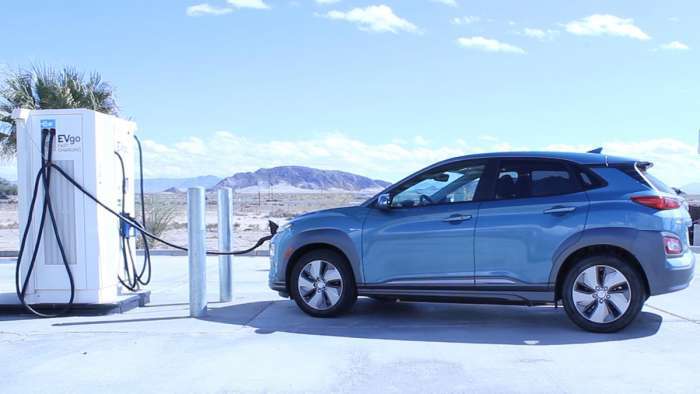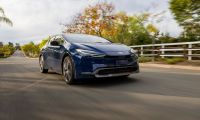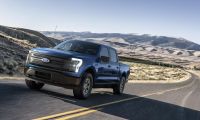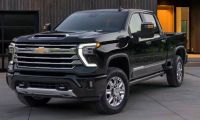I was able to check out the new 2020 Chevrolet Bolt EV in person at the LA Auto Show, but at this point, I still have not been able to test the 2020 Chevy Bolt EV's DC fast charging rate myself. However, a number of journalists were invited to drive 2020 Bolt EVs from Seattle through Astoria and on to Portland (a distance of 240 miles – slightly more than the outgoing 2019 Chevy Bolt EV's rated range), and at least a couple of those groups chose to charge the 2020 Bolt EV at an Electrify America site capable of maxing out the Bolt EV's charging rate.
Despite hoping for more, it appears that the 2020 Chevy Bolt EV's peak charging speed has not improved significantly from previous years (though GM states that the new Bolt EV can now charge 150% faster in cold weather), but I am a person who prefers to "trust but verify." In this case, that applies both to the journalists who claimed a peak charging rate of 55 kW and to GM's claims of 150% faster cold weather charging. I plan to test both thoroughly.

Even without testing myself, though, as a Bolt EV owner for 3 years with hundreds of DC fast charging sessions under my belt, I can identify a couple of subtle improvements might have gone unnoticed by the media. As far as I can tell, only one of the journalists invited to do the drive actually owns and drives a Bolt EV (Nikki Gordon-Bloomfield of Transport Evolved), and she chose to drive the entire route without stopping to recharge.
In this story, I will discuss what we know about the 2020 Chevy Bolt EV’s updated range and charging, but I will also identify some subtle improvements that might have occurred without anyone noticing. Finally, I will illustrate how these subtle changes could offer significant improvements to real-world driving and travel.
The 2020 Chevrolet Bolt EV Has 21 More Miles of Range
From the outset, the biggest headline regarding the 2020 Chevy Bolt EV was the increased range and battery capacity. This new Bolt EV now has a 66 kWh battery with 259 miles of rated range (up from the 60 kWh battery and 238 miles of rated range in the previous Bolt EVs). While a 10% boost in battery energy and 21 miles of additional rated range is still only an incremental improvement, it might be a bigger deal than it appears.

It's not just that the Bolt EV now surpasses its similarly priced EV competitors such as the Hyundai Kona Electric (258 miles) and Tesla Model 3 SR+ (250 miles) in estimated range. The Bolt EV consistently meets or exceeds its EPA ratings, and it does so while offering significantly more cargo and human capacity than either of those two competitors.
In my 2017 Chevy Bolt EV, I make my regular 1,000-mile trip to Northern California often enough that it's become a sort of game to see how quickly I can travel. The total travel time is typically around 20 hours depending on traffic and weather, and it includes 3.5 to 4 hours of time spent charging one the road – depending on whether I start each 500-mile leg with a full battery.
In order to maintain those average trip speeds of well over 50 mph in my 2017 Chevy Bolt EV, I often need to dip down to as low as 5% battery between charging stops. One of the most common comments from fellow Bolt EV owners on my channel is that they would love to travel that quickly, but they would be uncomfortable regularly dipping below 10% to 15% battery while traveling.
After over 100,000 miles, my Bolt EV's battery has degraded a little more than 5%; however, even when my 2017 Bolt EV was brand new, it had 10% less capacity than the 2020 Chevy Bolt EV. That means that, though the 2020 Bolt EV's charging rate has remained largely unchanged from previous years, even conservative, risk-averse drivers will be able to maintain average travel speeds of close to 55 mph without ever dipping into the low battery warning at 15%.
For reference, that would make the 2020 Chevy Bolt EV competitive with most other cars in its class according to Bjorn Nyland's 1000 km speed tests.
The 2020 Chevy Bolt EV Adds More Range at Peak Charging Speeds
The next impact this increased battery capacity and range has is that the 2020 Chevy Bolt EV will add more range at its fastest charging speeds. Essentially, 50% of a 66 kWh battery is more than 50% of a 60 kWh battery. The reason 50% battery is significant is because when the 2017 Chevy Bolt EV's battery is at ideal temperatures, it will hold its peak charging rate to as high as 55% battery. However, under typical operating conditions, that stepdown usually occurs at 50%. After that point, the charging rate will drop down.
For now, let's assume that nothing else has changed with the charging curve for the 2020 Chevy Bolt EV, and the step down in charging rate from 55 kW (150 A charging current) to less than 40 kW (105 A charging current according to my readings) occurs at 50% battery. For a 2017 Bolt EV, 50% battery is 30 kWh (enough for about 105 miles at typical freeway efficiency – about 3.5 mi/kWh), but for a 2020 Bolt EV, 50% is 33 kWh (about 115 freeway miles). That might not sound like much, but again, that's a 10% increase in range at the Bolt EV's fastest charging speeds.
If a Bolt EV owner charges to 65% to 70% instead (a practice I highly recommend because the Bolt EV will use excess power from the charger during this time to condition the battery and cabin), a 2020 Bolt EV owner will now add just over 46 kWh (over 160 freeway miles) between charging stops instead of the 42 kWh (147 freeway miles) that a previous Bolt EV owner would add. And again, 15 miles isn't a huge difference, but it starts to chip away at the number of stops needed to complete a long trip.
What’s more, if the 2020 Chevy Bolt EV can maintains a higher charging rate for longer, those 160 miles might arrive sooner than 145 miles in previous Bolt EVs.
The 2020 Chevy Bolt EV Charges Faster for Longer
This next consideration is one that I think might be too subtle for a non-Bolt EV owner to recognize, but it offers a significant improvement. While everyone was focused on peak charging rates, the Bolt EV would actually see a bigger improvement from sustaining peak charging rates for longer. GM stated that they improved the 2020 Chevy Bolt EV's battery impedance (lowering internal resistance), which should enable it to maintain a faster charging rates for longer. That could present two significant improvements.
First is that the initial charging rate step down from 55 kW (150 A) that commonly occurs at 50% battery under typical conditions might now occur at 55% more consistently. The result would a 20% improvement in the amount of energy the 2020 Chevy Bolt EV will add under its fastest charging rates.
Essentially, under typical driving conditions and assuming that both charge sessions are started at 10% battery, an earlier model Bolt EV charging to 50% battery (a ~27 minute charge) will have gained 105 freeway miles while a 2020 Bolt EV charging to 55% battery (a ~33 minute charge) will have gained 127 freeway miles. Now yes, the second session is about 6 minutes longer, but if a Bolt EV owner needed 120 miles to get to their destination regardless, they would rather spend 6 minutes adding that range than 10 minutes.
The second potential improvement is what happens at that stepdown. One of my primary criticisms of the 2017 to 2019 Chevy Bolt EV is that, when the first charging rate step down occurs, the charging current drops to 105 A, or less than 40 kW. To me, this seems unnecessarily aggressive, considering it is nearly a 30% loss in charging rate; however, I might be convinced that it is appropriate given the original Bolt EV's 60 kWh battery capacity.

In practical terms, this means that even on the most common 50 kW, 125 A public DC fast chargers, the previous model year Chevy Bolt EVs are no longer maxing out the charger. The only thing that makes this aggressive step down tolerable is that the Bolt EV can draw as much as 20 A of additional current from the charger after this step down, which enables savvy Bolt EV owners to precondition their vehicles before ending the charging session. However, while conditioning the battery and cabin can indirectly add miles (energy that doesn't need to come from the battery when driving), it doesn't add actual miles of range.
If, however, the 2020 Chevy Bolt EV can maintain a faster charging rate after the step down from peak charging, the difference would be notable. For example, if the new step down is now to 125 A of actual charging power, it means that the new Bolt EV could max out the most common 50 kW chargers all the way up to 70% battery. In real-world terms, that means that a one-hour dinner break when plugged into a 50 kW charger would charge the 2020 Bolt EV up to 70%, giving the owner enough range for another two hours of driving at freeway speeds.
What is more, if the behavior is consistent with previous Bolt EVs, when using 150 A or faster DC fast chargers (such as Electrify America's 150 kW or 350 kW chargers), a 2020 Chevy Bolt EV would be able to take excess power from the charger to condition the battery and cabin while still charging at 45 kW to 50 kW.
In the end, 2020 Chevy Bolt EV owners aren’t likely to see a significant difference in typical charging session times than they would in earlier Bolt EVs; however, those charging sessions would be far more productive than they were in previous Bolt EVs. In the real world, those subtle changes could significantly improve long-distance travel experiences.
A 2020 Chevy Bolt EV on My Regular 500-Mile Drive
In order to complete my regular 500-mile trips to and from Northern California, I currently make three charging stops in my 2017 Bolt EV. Each time I stop, I end up charging up to between 60% to 70% battery, depending on conditions and what I need to do during the trip. In theory, I could make the trip with only two stops, each time charging up to about 80% to 85%; however, despite saving the time wasted making a third stop, it would still be slower because of the additional time needed to charge up to over 80% (even on the fastest chargers, the average charge session would be over an hour).

If the 2020 Bolt EV (with its 21 miles of additional range) can maintain faster charging rates to 70% while also drawing additional energy for battery and cabin conditioning, I could easily make my regular 500-mile trips with only two stops. So while the 2020 Bolt EV would still be nowhere near as capable of maintaining the same, relaxed 65 mph average travel speed that my Chevy Volt could maintain along that route while making my two customary stops, it could still mark a significant improvement over my 2017 Bolt EV.
The benefit of only making two stops is that over the course of 8 hours’ worth of driving, I try to have a meal break, which roughly corresponds with the time spent charging. Essentially, it’s sunk cost. Outside of that, I also typically need to make one bathroom break and possibly do some shopping along the way. So even a second 30 to 40 minute stop would be sunk cost for me. The third stop that my 2017 Chevy Bolt EV requires me to make (with the sole purpose of recharging the car) is inconvenient. I’ve gotten used to making a third stop (I have found uses for my time), but I’d rather not need to.
This two stop itinerary for driving 500 miles is something that – much to my chagrin – the 2019 Kia Niro EV was also unable to achieve comfortably (due primarily to its efficiency and range). For me, this "two stops for 500 miles" standard is perhaps my most basic test for whether I feel an electric vehicle would present a significant enough improvement over my 2017 Bolt EV to warrant an upgrade. At this point, it appears that only two cars make the list of affordable (sub $40,000) electric vehicles that can comfortably achieve that standard: the Hyundai Kona Electric and Tesla Model 3 SR+. However, if even some of my assumptions about the 2020 Chevy Bolt EV are true, it would also make that list.

Granted, that 500-mile trip is a unique, personal use case, but I think it is reflective of how capable electric vehicles are of traveling in general. For those who prefer their travel to be relaxing road trips, any of those EVs would do. For those who demand cannonball run speeds, we are perhaps still a few years away. I sit somewhere in between, where I want to make trips that are both quick and reasonable. That means stops that make sense. Not 10 to 15 minute “splash and dash” stops, and not hour-long waits with two more stops to come. Enough time to enjoy a meal, do some shopping, and stretch my legs. It looks like the 2020 Chevrolet Bolt EV might be capable of that.
Conclusion
Unfortunately, it will still be a few weeks before I am able to fully test the new 2020 Chevrolet Bolt EV. However, that should enable me to test out some of its cold weather improvements because January, which is traditionally one of the coldest months in California. As a result, I should be able to test how much GM was actually able to improve its cold weather charging speeds.

I don't have one of my regular 1,000-mile trips to Northern California scheduled, so I might not be able to directly compare the 2020 Chevy Bolt EV to my 2017 Chevy Bolt EV and the 2019 Kia Niro EV using the same route. Still, I should be able to gather a lot of hands on data to compare the refreshed Bolt EV with other similarly priced electric vehicles on the market, and I'll be able to assess the full impact of its additional 21 miles of rated range and improved DC fast charging.
About The Author
Eric Way focuses on reporting expert opinion on GM brand electric vehicles at Torque News. Eric is also an instructional designer and technical writer with more than 15 years of writing experience. He also hosts the News Coulomb video blog, which focuses on electric vehicles, charging infrastructure, and renewable energy. Eric is an active member of the EV Advocates of Ventura County, a volunteer organization focused on increasing the widespread adoption of electric vehicles. You can follow Eric on News Coulomb Youtube, on Facebook at @NewsCoulomb as well as on Twitter at @eway1978.













Comments
Great. Reporting. Was leaning
Permalink
Great. Reporting. Was leaning toward model 3 but now tilting toward bolt. Thinking LT with safety package. Local dealer at $27k for 2019. Good buy?